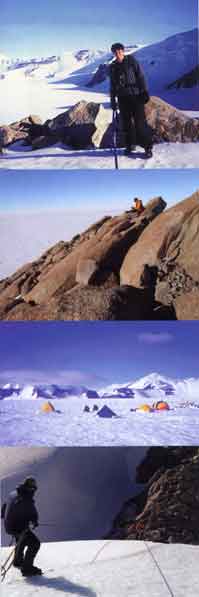
from UMaine Today September / October 2005
Last winter, University of Maine master's student Aaron Putnam was in the TransAntarctic Mountains on an expedition that included some extreme rock collecting. He and members of a research team rappelled into wind-carved ice moats, scaled sheer cliffs and chipped away at boulders, looking for clues about the stability of the two ice sheets that cover Antarctica.
Their camp was in the Bottleneck, a critical junction between the East and West Antarctic ice sheets. Ice flows through this gap from east to west between the mountains. What scientists have yet to understand is whether ice on the west buttresses ice on the east. If it does, the Bottleneck could provide the only major passageway from one side of the continent to the other.
Furthermore, the fates of the two ice masses would be linked. The West Antarctic Ice Sheet is smaller and more vulnerable to collapse because it sits on bedrock below sea level. If rising seas caused it to disintegrate, scientists wonder what would happen to ice on the eastern side of the mountains. Could enough ice flow through the Bottleneck to destabilize the East Antarctic Ice Sheet?
Part of the answer may lie in the rocks that Putnam and his team collected. At the height of the last Ice Age, Antarctic ice bulged through the mountain gap and, as it receded, left behind so-called "bathtub moraines," rocks and boulders layered in rings on the surrounding mountains. By determining when they were deposited, the scientists hope to define when and how high the ice crept up the mountainsides, and how much the level of the ice has declined since then. That information could help determine if the Bottleneck serves as a wide open valve for east Antarctic ice or if ice flow is limited by the shape of the bedrock and surrounding mountains.
With Putnam on the expedition were Robert Ackert and Sujoy Mukhopadhyay of Harvard University, and mountaineer Peter Braddock. UMaine emeritus professor Harold Borns helped plan the expedition; Brenda Hall, assistant research professor in the Climate Change Institute, is Putnam's adviser. Support came from a $130,135 National Science Foundation grant.
The researchers shipped home about 1,000 pounds of rocks, most of them to Harvard, where they will be analyzed with cosmogenic dating to determine when the rocks were first exposed at the Earth's surface. As soon as rock is exposed to the sky, it is hit by cosmic rays that cause chemical changes in the minerals. These changes create by-products, forms of beryllium, neon and helium, for example. Just how much of these by-products have accumulated provides an indication of how long the rocks have been exposed.
At UMaine, Hall is setting up a lab to conduct cosmogenic dating on the rocks that Putnam sent to Orono. For his thesis in geology, Putnam is focusing on how the rock deposits may indicate how the climate in the Bottleneck region has changed over time.
